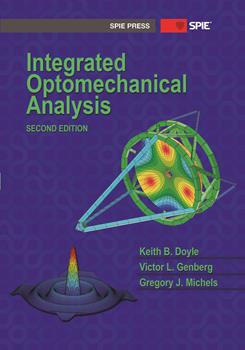|
Thermal, structural, and optical analyses are performed to predict the optical performance of a double Gauss and a seven-element lens assembly due to on-axis heat loads. In the double Gauss lens assembly, optical performance is computed as a function of power, and in the seven-element lens assembly, optical performance is computed as a function of time for a fixed power. 14.1 Double Gauss Lens Assembly Thermal, structural, and optical modeling tools are used to predict the optical performance of a double Gauss lens assembly subject to an on-axis heat load as shown in Fig. 14.1. System specifications are listed in Table 14.1. A fraction of the heat load is absorbed by the optical elements via bulk volumetric absorption, resulting in thermal gradients in the lens assembly. The on-axis wavefront error, point spread function, modulation transfer function, and the change in focus is computed for incident powers of 40, 80, 120, 160, and 200 W. The surface numbering for the double Gauss lens is shown in Fig. 14.2. 14.1.1 Thermal analysis A thermal analysis is performed to compute the temperature distribution in the lens assembly due to the bulk volumetric absorption of the heat load. A two-step modeling effort was conducted using the thermal analysis software Thermal Desktop. First, a heat-rate model was developed to compute the energy absorbed. A heat source was defined in the heat-rate model to emit a parallel radiation flux, and a mask was used to set the clear aperture for the lens assembly. Multiple surfaces of zero thickness with the appropriate indices of refraction were then defined for each lens element. The surface absorption coefficients were radially varied to account for the absorption characteristics of each glass and the energy distribution of the heat source. The radiation flux was varied to yield the desired incident power. The resulting heat rates were then used in a steady-state thermal analysis to compute the temperature distribution for powers of 40, 80, 120, 160, and 200 W. The resulting temperature distribution is a radial gradient with a slight axial variation due to surface effects as shown in Fig. 14.3. The approximate radial gradient as a function of power is listed in Table 14.2. The temperatures were subsequently mapped to a MSC/Nastran finite element model using the shape function interpolation algorithm in Thermal Desktop, as demonstrated in Fig. 14.4. |
|
|


